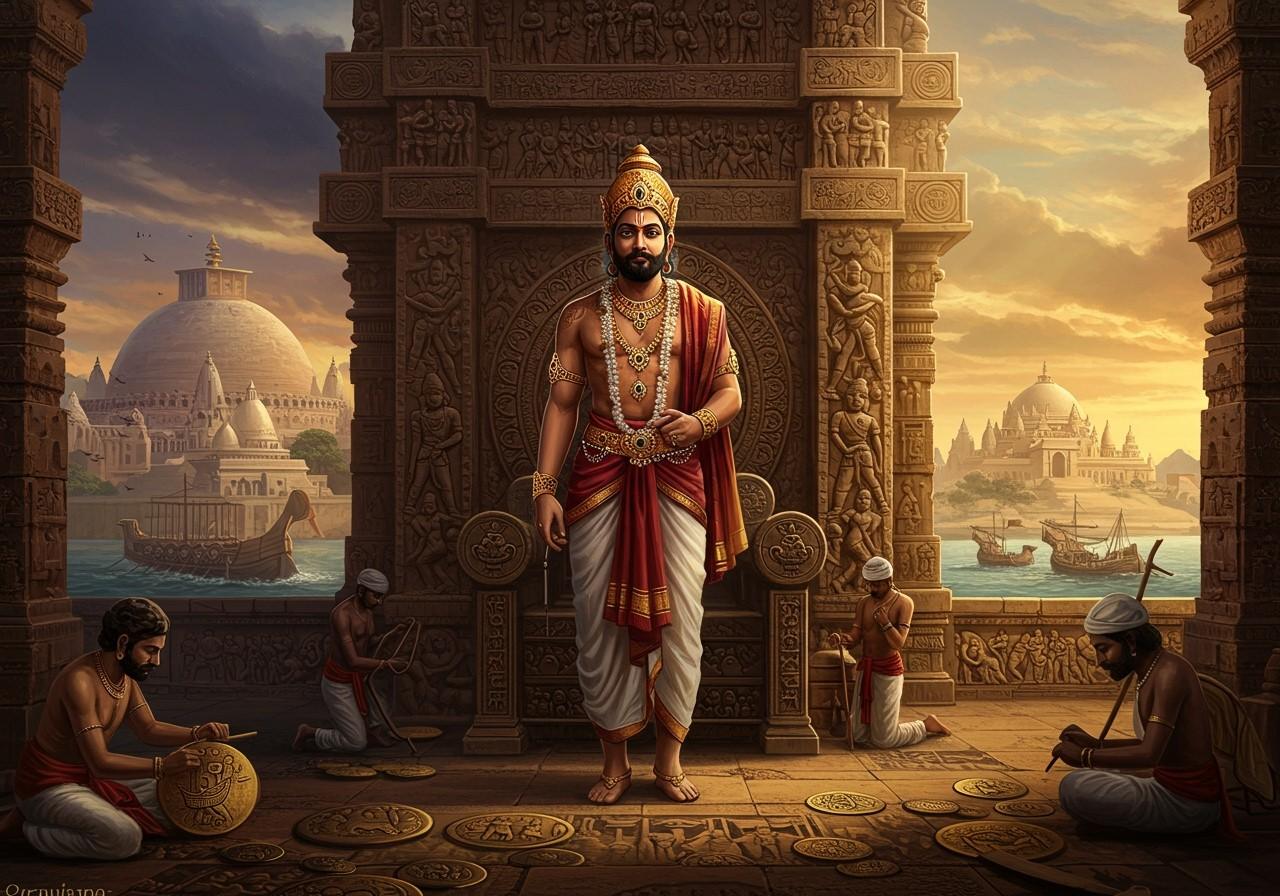
The Satavahana Dynasty, also known as the Andhras, holds a significant place in the annals of ancient India. Ruling from the late 2nd century BCE to the early 3rd century CE, they were pioneers in establishing a Deccanese empire across the southern region, encompassing present-day Andhra Pradesh, Maharashtra, and Telangana. With capitals at Pratishthana (Paithan) and Amravati, their reign is documented in the Puranas and various inscriptions.
Historical Background
Emerging around the late 2nd century BCE, after the decline of the Mauryan Empire, the Satavahana dynasty, founded by Simuka, solidified its power in the Deccan region. Their rule, spanning several centuries until the early 3rd century CE, marked a period of significant development and influence.
- Geopolitical Context: Ancient India was a mosaic of regional powers. The Satavahanas engaged with these neighboring kingdoms and empires, forging alliances and navigating political complexities. Their interactions shaped the political landscape of the Deccan and beyond.
- Key Sources: Our understanding of the Satavahana period comes from various sources, including the Puranas, a collection of ancient Hindu texts, and inscriptions found on rocks, pillars, and coins. These provide valuable insights into their history, culture, and achievements.
Who Were the Satavahanas?
The Satavahanas were an ancient Indian dynasty that presided over the Deccan Plateau and parts of Central India. Believed to be descendants of the Andhra tribe, they are often referred to as the Andhra rulers. Their legacy is intertwined with the rich cultural heritage of the region.
- Etymology: The name “Satavahana” is derived from Prakrit, believed to mean “driven by seven” or “seven-horse chariot,” symbolizing their power and authority. This name reflects their prominence and influence in the region.
- Notable Rulers: The dynasty boasts prominent rulers like Simuka, the founder, and later Gautamiputra Satakarni and Vasisthiputra Pulumavi, who played pivotal roles in expanding the empire’s reach and consolidating its power. Their reigns marked significant periods of growth and prosperity.
Political and Administrative Structure
The Satavahanas implemented a sophisticated administrative system that contributed to their effective governance and the stability of their empire. This structure played a crucial role in maintaining order and promoting prosperity.
- King’s Authority: The king held supreme authority, supported by a council of ministers who advised on matters of state. This system ensured a balance of power and facilitated informed decision-making.
- Rajukula: The royal family, known as the Rajukula, played a vital role in maintaining dynastic continuity and ensuring a smooth succession of power. This contributed to the long-term stability of the empire.
- Provinces: The kingdom was divided into provinces, each governed by a Mahamatra, or provincial governor, who oversaw local administration and ensured the implementation of royal decrees. This decentralized system allowed for efficient management of the vast empire.
- Local Administration: Village assemblies and guilds played a significant role in local governance, giving communities a degree of autonomy and fostering civic participation. This decentralized approach strengthened the empire’s foundation.
Economic Contributions
The Satavahanas were instrumental in promoting trade and commerce, contributing significantly to ancient India’s economic growth. Their policies and infrastructure development facilitated both internal and external trade, leading to increased prosperity.
- Trade Networks: The Satavahanas established extensive trade networks, connecting India with the Roman Empire and Southeast Asia. These networks facilitated the exchange of goods, ideas, and cultures.
- Trade Routes: Important trade routes like the Dakshinapatha, meaning “southern road”, facilitated the movement of goods and people across the empire and beyond. This promoted economic integration and cultural exchange.
- Economic Impact: The flourishing trade under the Satavahanas had a profound impact on the economy, leading to the introduction of coinage, the development of urban centers, and the growth of various industries. This period witnessed significant economic progress.
- Agriculture: The Satavahanas recognized the importance of agriculture and implemented policies to promote agricultural practices and irrigation systems. This ensured a stable food supply and contributed to the overall prosperity of the empire.
How Poojn.in Helps Preserve Satavahana-Era Spiritual Traditions
The Satavahana Dynasty held strong connections to Shaivism, with many rulers being devotees of Lord Shiva. Poojn.in (https://www.poojn.in), India’s largest cultural goods and services store, helps preserve these ancient spiritual traditions by offering a wide selection of authentic puja items and materials.
For those seeking to honor Lord Shiva as the Satavahanas did, Poojn.in provides:
- Pure copper and brass items for abhishekam rituals like copper snakes and brass trishuls.
- Traditional rudraksha malas and sacred threads for personal worship and spiritual practices.
- High-quality bilva leaves and dhoop for offerings and creating a sacred atmosphere.
- Authentic panchamrit ingredients for abhishekam and other rituals.
- Pure silver items for temple offerings and personal use. Explore our range of Shiva Lingams and Nandi sets.
Poojn.in also offers specific items for major Shiva festivals like Maha Shivaratri and Shravan Maas, festivals likely celebrated during the Satavahana era. All products are carefully packaged to preserve their ritual purity. Visit Poojn.in to explore our complete collection and continue these ancient traditions.
Conclusion
The Satavahana Dynasty’s legacy is deeply woven into the historical fabric of Andhra Pradesh and India. Their contributions to political administration, economic development, and cultural enrichment have left an enduring impact. From establishing a robust governance system to fostering trade and agricultural advancements, the Satavahanas shaped the region’s prosperity. Understanding their history provides valuable insights into India’s rich past and the significance of these ancient rulers. Explore more about Andhra Pradesh’s rich culture and history through our blogs on Andhra Pradesh: A Journey Through Time, History, and Formation, Andhra Pradesh Cuisine: A Culinary Journey, and Andhra Pradesh State Symbols: Exploring Regional Identity.


